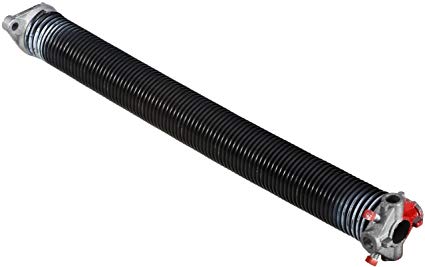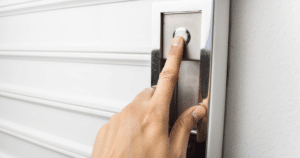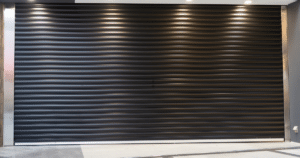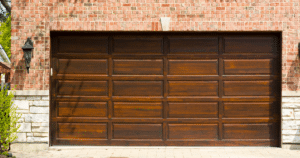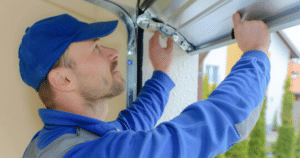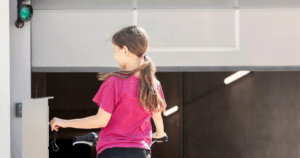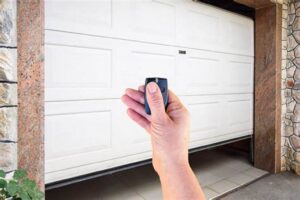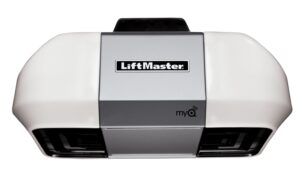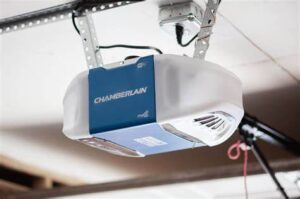What are Torsion Springs?
Torsion springs are heavy duty coils under extreme amounts of tension. These coils are responsible for carrying the weight of your garage door – winding and unwinding to do so. Torsion springs are anchored to the wood header above the garage door using a center bearing plate for support. Residential Garage door torsion springs come with life cycles ranging from 10,000 – 100,000 cycles depending on their length and wire gauge. Torsion springs can come as a single spring system or in pairs, depending on the size and weight of your garage door system.
Why Do Torsion Springs Break?
Garage door springs are nearly 100% responsible for lifting the weight of your garage door. This puts them under extreme amounts of pressure every moment of every day. Garage doors often weigh several hundred pounds, which is why such a high amount of tension is necessary to keep your garage door properly balanced. The rest of the mechanisms of your garage door are mostly there to guide the door in the right direction while the torsion springs do the heavy lifting.
Residential Torsion springs can have lifespans of anywhere from 10,000 to 100,000 cycles. A cycle refers to completely opening and closing the door. This means that with regular daily use, residential torsion springs can have lifecycles of anywhere from 5 years to 100 years, depending on how many cycles your garage door system comes with of course and proper maintenance. A torsion spring may break due to natural wear-and-tear as it approaches its life cycle limit.
However, other things can also affect your torsion springs’ life cycle. For example, the ball bearings in your torsion springs center bracket and end bearing plates may become stiff, lock up and stick with time. If these bearings grind down, it makes it harder for the shaft and torsion springs to turn, and this can easily cut your springs’ life cycle down to a third. Garage door rollers can also be a big problem for your torsion springs if the ball bearings there are also allowed to wear down and lock up. This of course, would require the torsion springs to do more work in order to move them and the garage door along their tracks. These issues will reduce your torsion springs’ life cycle significantly.
Your garage door’s mechanisms work together with one another to maintain proper use and ensure the maximum lifespans for all of them.
Two types of torsion springs commonly exist: oil-tempered springs and zinc-galvanized springs. Both oil-tempered springs and zinc-galvanized springs require annual readjustment in order to continue functioning as intended. Neglecting annual adjustments of your torsion springs will often result in shortened cycle life.
Common Symptoms of A Worn or Broken Torsion Spring
Sometimes you may find that your garage door opens up by a few inches and then stops, or that it opens up at an incredibly slower than usual pace. This can sometimes be a sign of a worn or broken garage door spring/s. If this happens, use the garage door opener to close the garage door as normal. Once the garage door is fully closed, pull the emergency release cable. Next, try to lift the door manually. If the door feels very heavy and will not move easily, it is likely that your torsion springs are worn or broken.
Another clue that you may have a broken torsion spring may reveal itself through a loud bang emerging from your garage. This can be extremely loud, and can often sound like a car crash or burglar breaking into your home. This bang is a result of the large amount of tension that your broken torsion spring has released all at once.

If you believe that your torsion springs are broken, try pulling the emergency release while the garage door is closed. If you cannot open the door manually when it is disconnected from the garage door opener, it is likely that the torsion springs are broken. If the torsion springs are functional, the door should open relatively easily when disconnected. You will be able to open the door manually if the torsion springs are broken, however, it will most likely require multiple people to do so.
You may also find that your garage door is “jerky” when opening and closing. This could simply require lubrication of the moving hardware and ball bearings. It could also demonstrate that if you have a pair of torsion springs, one may be broken and is struggling to carry the load by itself.
What To Do If You Have A Worn or Broken Torsion Spring
First and foremost, garage door springs can be very dangerous if not handled properly and professionally. DO NOT disconnect the door by pulling the red emergency release handle while the door is in an open position. If you disconnect the door while it is open, you risk the several-hundred-pound door crashing to the ground due to the lack of the support of the torsion springs. This is completely dangerous and can result in injury or loss of life. You can also seriously damage your garage door system which may result in unnecessary garage door or opener repair. Call your favorite garage door professionals at Team Taylor Doors for same or next day repair.
Although DIY garage door spring replacement is possible, there are a lot of steps that must be followed accurately and there are a lot of potential dangers involved. Garage door torsion springs hold high amounts of tension within them, and mishandling the springs has to potential for them to release this tension.
As mentioned earlier, some garage door systems come with a set of torsion springs, while others come with single spring. If one spring in a pair breaks, we generally recommend replacing both of your springs at the same time. Though it may be tempting to save money, if one spring breaks in a pair, then the other is likely to break within a short period of time as they have had the same amount of cycles used.
Your garage door springs are critical to the safe operation of your garage door, but they can be extremely dangerous if not handled properly. Never attempt to disconnect the door by pulling the red emergency release handle when the door is open—it could lead to serious injury or even death, as the door might crash down due to the lack of torsion spring support. Instead of risking damage to your garage door system or personal harm, trust the experts. Call Team Taylor Doors for professional, same or next-day garage door repair in Kansas City. We’re here to ensure your garage door operates safely and reliably. Don’t take chances—let us handle the tough stuff!

